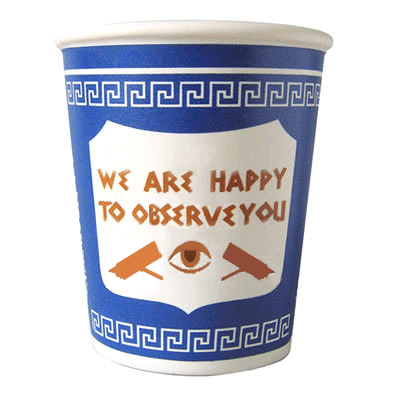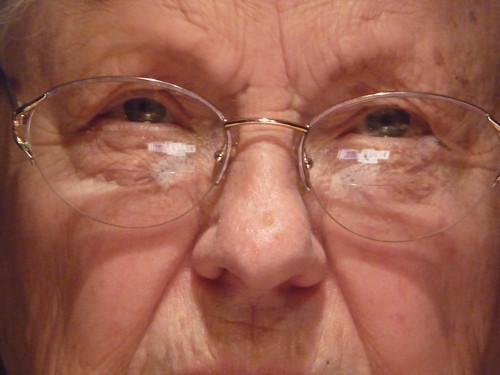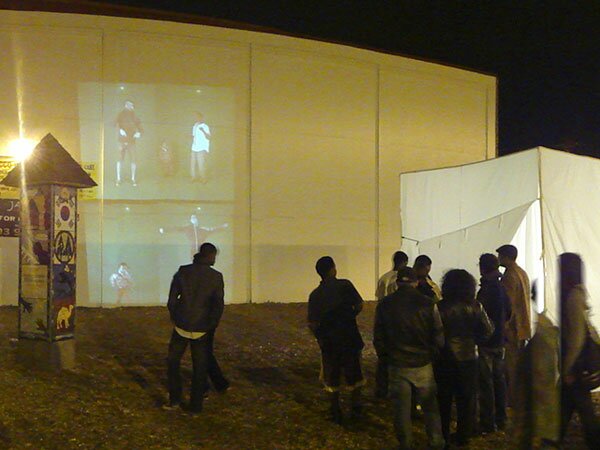The Observatorium exhibit on a hand cart is slowly shifting from thinking and tinker mode to reality. In the meantime, there is a rich, expansive project by the same name I came across in my research. While the reality and trajectory of the concept as a San Francisco Mobile Museum exhibit is of course different, there is a lot of inspirational thinking here.
The project "Observatorium" is out of Rotterdam, The Netherlands, and is an artist-group comprised of Geert van de Camp, Andre Dekker, and Ruud Reutelingsperger. In 1993 van de Camp made some "large, modular sculptures" and Dekker, a graphic designer took up residence in it, and Reutelingsperger, a painter, used it as an exhibition space. The resulting conversations and subsequent work around these ideas of building, exhibiting and perception formed the nucleus of their work- a series of installations that are thoughtful (beautiful), habitable, spaces for artists and individuals alike to spend time in.
In 2010 they published a book on the project "Big Pieces of Time, Observatorium". The book is a fantastic overview of their "design philosophy" and how it evolved during the course of the projects.
"They take the grey areas and overlaps of urban design, landscape architecture, architecture and art, and make them productive. Instead of creating autonomous art in public space, Observatorium uses the media of sculpture and installation to make functional facilities. The results are monumental, symbolic and meaningful. As a way of communicating their knowledge, Observatorium founded the Open Air University. It presents student workshops and programmes of co-creation."
Big Pieces of Time is an overview of their design philosophy and is itself shaped by it. It is a text which informs, philosophizes, inspires and goes discipline-hopping. The photographs, illustrations and narratives together form a lively and evocative account of Observatorium’s projects. It includes some intriguing reflections by members of the public who have inhabited the sculptures."
As mentioned above, the Observatorium team also teaches Public Art and Place Making in Europe and the US "preferably outdoors" through their project Open Air University. Students will be at work where "Observing, researching, philosophying and constructing go hand in hand."
Their Observatorium project developed a series of mottos or manifesto, as a result of their work. They published them in their book and online. I thought I would share them here:
Observatorium mottos
Time and Space for Focussing Attention
Art needs a spectator. Creating time and space for focussing attention means giving, through the work of art, ample time and space to the spectator. The exhibition space takes on the nature of a dwelling, an opportunity for meaning to arise in the course of a prolonged, uninterrupted stay.
Otium – Negotium
An observatorium is a paradoxical space into which you withdraw in order to determine your relationship to the world. Perception of the surroundings is impossible without a gaze into the inner self. Isolation is a form of participation.
Linking Separate Worlds
Observatorium takes a stand against thefragmentation of the world into separate zones for working, leisure, transport, shopping, housing, nature and waste. Observatorium rejects the boundaries between the separate worlds, and uses them to make connections.
Civilization Is Maintenance
Observatorium makes works of art that are "unfinished" and which develop in time. Civilization is similarly not a snapshot in time but a process. Maintenance is part of that development, not of the status quo.
The work Is Not Finished Until Someone Uses It
Observatorium orchestrates liveliness and provokes people to expand or modify their projects and sculptures. The basis for a public sculpture is established by a claim on space. The basis for a lively public space is appropriation by people.
Make Use of Conflict
Conflict and rancour exist alongside harmony and civilization. Art does not take sides, but worms its way between these opposites and makes proposals for coexistence. Turn antitheses into ostensible antitheses.
Design What Is There
Emptiness and silence are hard to design. Where available, Observatorium incorporates these characteristics into the design. There are three ways to do it: do nothing, protect them, and make them visible.
A sculpture is Ideally Three Things
A sculpture is ideally three things: a work of imagination, a reflection on the surroundings and a foundation of communality. It is there to be accepted and experienced, it discloses the nature of the context and motivates action.
Cella, Courtyard, Domain
Diversity of space arouses curiosity and creates diversity of use. The succession of cella, courtyard and domain, phases the fluid links between inside and outside. Private and public are established in dialogue.
The World, As Told
Observatorium makes sculpture for observing the world. It has to be used. The artist can initiate any sort of use which responds to the needs and ideas of the people it was made for. If he is the host in his own work, he is able to tell the story of its use and include reflections by others in his body of work.
Standstill and Movement
Space for speed is always surrounded by slow space. These spaces are usually separated as much as possible. Observatorium promotes sculpture that links these spaces together and creates opportunity for observation.
Antonello
An "Antonello", in Observatorium's parlance, is a public space in which a spectator may see an observer inside a sculpture. The sculpture is an object into which the person has withdrawn in order to perform some self-imposed task, while himself remaining observable and possibly open to interruptions. The thin line between public and private ins inhrrent to the nature of the encounter of observer and spectator.
(Observatorium: Geert van de Camp, Andre Dekker, and Ruud Reutelingsperger)














































